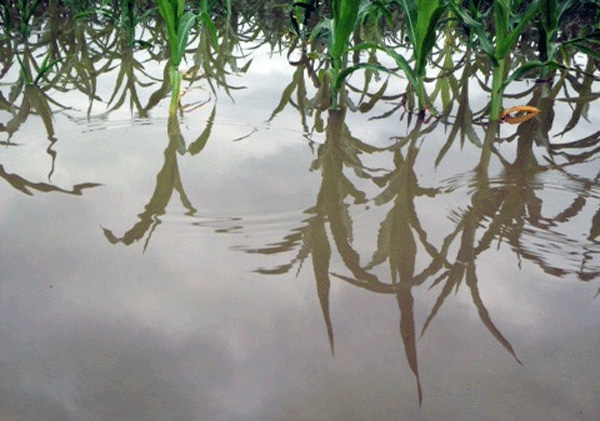July 11, 2016

Reports of flooded corn are coming in from around Kentucky. Corn survival is dependent on the crop stage, the depth of flooding, the duration of flooding and the soil type in the field as well as other factors.
The following are some key points to corn survival after flooding:
Much of the corn flooded in Kentucky is between tasseling and blister stage (VT to R2). If temperatures were greater than 77 degrees F the crop likely will not survive 24 hours of complete submersion.
The Kentucky Mesonet reported the July 5, 6 and 7 daily average temperatures near 77 degrees for Butler, Caldwell, Christian Counties and Henderson counties. You still want to inspect the fields, but you may want to call the insurance adjuster as well.
Normally, submerged corn is a bad option for silage because of the increased risk for Clostridium bacteria which hurts the fermentation process and increases the risk of botulism toxins.
For corn that was not completely submerged, it has a much better chance of surviving, but most likely will suffer a yield loss. Generally, if water was over the ear, we can expect more yield losses than if water did not make it to the ear. In addition, the area of yield loss in the field is usually larger than we expect.
Within about 24 hours of the flooding event, the air will be pushed out of the soils. That air contains carbon dioxide and oxygen which are vital to critical plant functions such as nutrient uptake and water uptake. Root hairs will kill off quickly in saturated conditions and new root hair growth will occur about 3 to 5 days once air moves back into the soil.
Please note, air movement back into the soil could be several days AFTER the water recedes. A corn plant may be without an effective root system for as much as a week (maybe more in clay soils). While the leaves and ears try to grow, there is no nutrient or water coming from the roots for a while.
The damage to the root system hurts nutrient uptake and crop development. The damaged root system is also more likely prone to drought stress later in the season. Stalk strength could be compromised as well. If the corn makes it to harvest, you may want to harvest these fields first, if possible.
Crop growth stage at the flooding event:
V14 to V16 (just before tasseling): tassel emergence will likely occur on schedule, but silking may be delayed. This could cause problems with pollination.
VT/R1: Stress of any kind during pollination is not good. Wait a week or so and assess the pollination success (or failure) in these fields.
R2 or later: If the husks were soaked, then expect a greater incidence of ear rots. Stalk rots are more likely later in the season as well.
For all fields, we cannot accurately begin to assess the extent of the damage until about three days after the water recedes. By then, we will know if plants survived. But, we will have to monitor these fields all the way through harvest to know if more problems could occur.
You May Also Like




